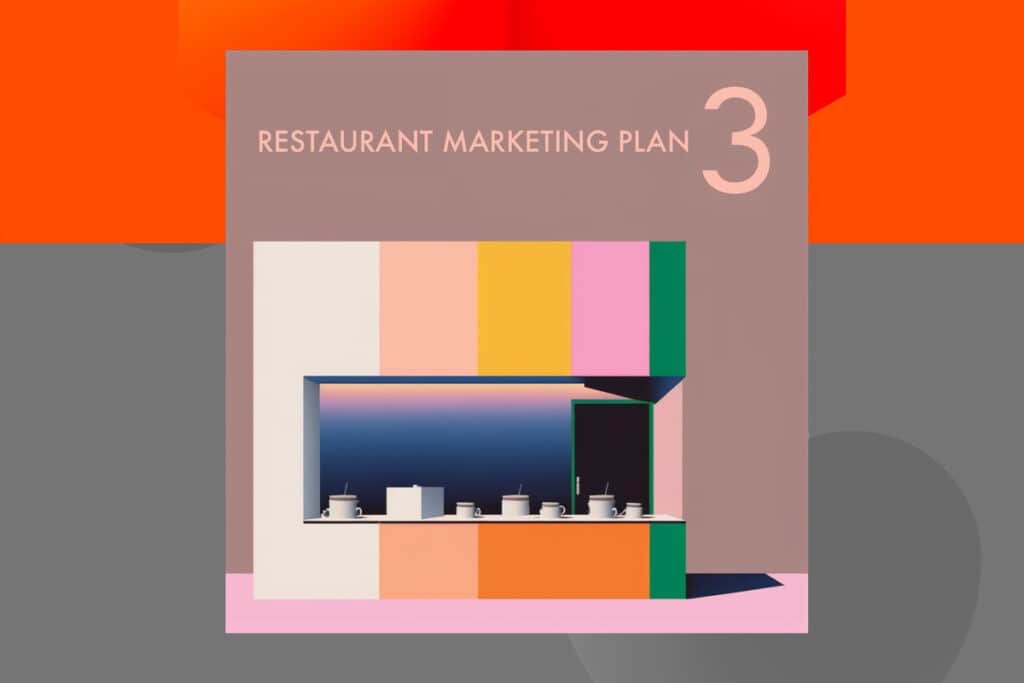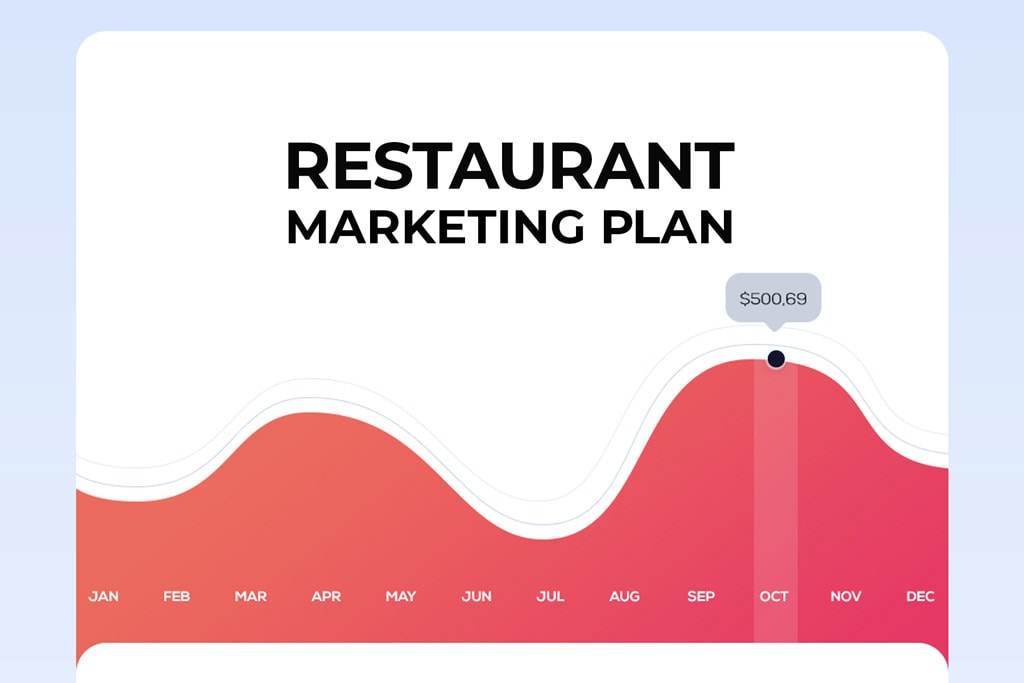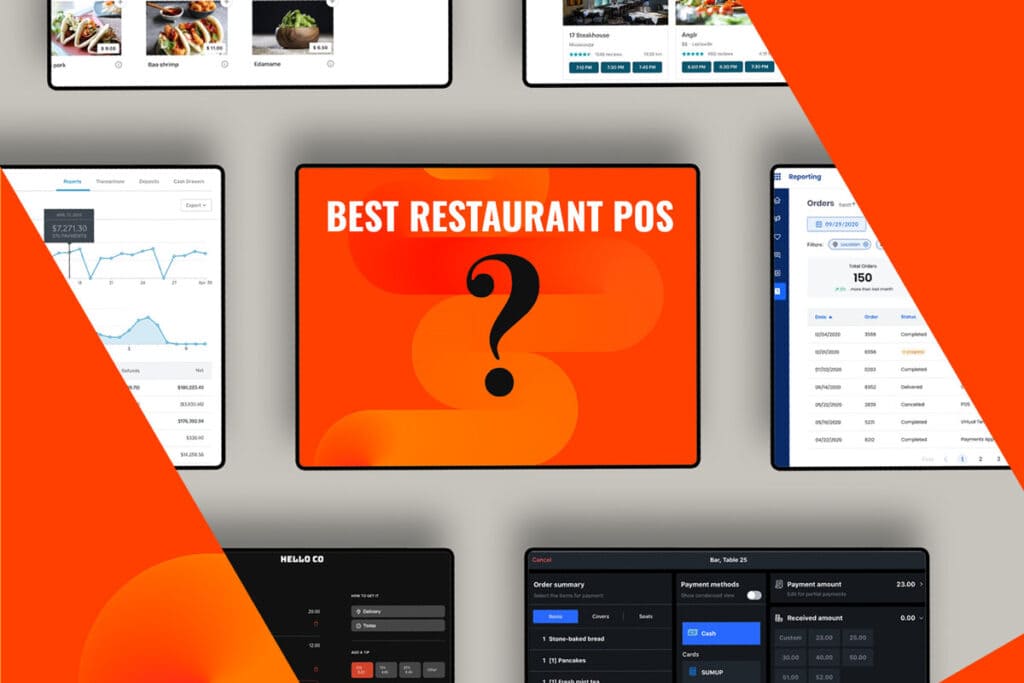If you’re a restaurant owner, you know marketing is essential to your success. Without a solid restaurant marketing plan, it’s not easy to attract new customers and keep them returning for more.
In this blog post, I will discuss how to create a marketing plan that drives results.
I’ll also provide a restaurant marketing plan template you can use as a starting point for your planning process.
Let’s get started!

If you own an independent restaurant, diner, or coffee shop, you likely already know how competitive the food industry is.
Statista Travel, Tourism, and Hospitality figures show over 660,000 restaurants in the United States alone. Most are small businesses, employing fewer than 50 employees.
The impact on the economy however is huge, with about 15 million workers in the restaurant business in 2022.
People become entrepreneurs in the industry for a variety of reasons. Maybe grandma’s pasta sauce was just too good not to share. Perhaps they enjoyed cooking as a youngster or were inspired by a television chef.
However, it can quickly become apparent that a stack of recipe cards may not be enough. Opening a restaurant can take far more skills than just cooking.
There is a location to find, vendors to bring aboard, and employees to hire. Even with all of this, advertising and marketing are ongoing challenges. After all, without a steady stream of potential customers, everything else you do can be for naught.
This guide will address the critical importance of a written marketing plan for restaurants. We define a marketing plan and its elements and share a basic restaurant marketing plan template.
What is a Marketing Plan?
At its core, a marketing plan helps a business establish and build increasingly valuable relationships.
A marketing plan is part of an overall business plan that addresses a business’s advertising and marketing aspects. The plan’s purpose is to ensure that your restaurant marketing strategies are timely and relevant.
This is especially critical today when opening a diner, or other eatery is more like embarking on a tech start-up than a place to enjoy Aunt Nellie’s sweet potato pie.
In recent years, various types of restaurant technology has impacted take-outs, online ordering, loyalty club memberships, food delivery services, and, yes, marketing and advertising.
Today’s marketing plans need to address traditional marketing efforts (print, radio, flyers, direct mail, etc.) and a number of established and emerging digital marketing channels like:
- Email marketing
- Social media platforms
- Food influencer marketing
- Text message marketing
- SEO and content marketing
The recipe for success in owning a restaurant today must include digital marketing.
I also think it’s important that your restaurant marketing plan in written down. Putting your marketing plan in writing makes it real and tangible.
Like many of our other goals, putting a plan down in writing seems to impact its value more while increasing the odds of its success.
A well-defined marketing plan sets standards for your business. As McDonald’s founder, Ray Kroc, is quoted as saying, “The quality of an individual is reflected in the standards they set for themselves.”
2 Essential Posts When Growing a Restaurant Business
As you are reading this article, also check out the two articles below!
Elements of a Restaurant Marketing Plan
You may be able to complete a lengthy road trip by setting out in a general direction. You’ll probably get there eventually. However, you will likely get there more quickly, efficiently, and effectively with a roadmap or GPS.
That is the purpose of a restaurant marketing plan: to serve as your guide, a road map if you will, to achieve your marketing goals.
So what are the elements of this roadmap?
Defining Your Target Market
The critical word here is “target.” It can be tempting to say “everyone” is in your target market, especially in the food industry. That, however, may only be true if you have unlimited resources to go after everyone.
The majority of small restaurants do not. Identifying those most likely to visit your business can be extremely beneficial. Is it young families? Singles? Those 55 plus? What is their income, what else do they spend time and money on, and what are they looking for in a dining experience?
Most importantly, how can you best reach them, and what message will resonate with them? Some businesses are going so far as to create “personas” of their ideal customer, including their first name, gender, typical family, type of job, etc.
This can help keep the focus where it should be.
Identifying Competitors
What competitors in your market appear to be going after your target market? What are their strengths and weaknesses? What are their customers saying in reviews? How are they advertising and marketing? What should you emulate, and what should you ignore?
Setting Marketing Objectives
It is important to keep goals and objectives realistic and attainable. It is usually good to be optimistic about your sales, but keep it real.
The longer you have been in business, the better you can rely on your seasonal history. You should lay out goals for an entire year, and while you may want to track sales daily or weekly, because of the nature of the business, monthly and quarterly goals tend to be the most useful.
Of course, you will want to increase as your business matures. You’ll want to account for slow periods and traditional seasonal boosts.
Research Marketing Options
This is one of the more challenging aspects of creating a written marketing plan for a restaurant. Not only should you research traditional marketing tactics like billboards, coupons, newspapers, and radio, but you will also need to include your digital options.
These should include a website, a social media channel like TikTok and Instagram, SMS text messaging, building an email list, influencer marketing, pay-per-click advertising, search engine optimization, a loyalty program, and more.
It is important to remember your restaurant customers and “persona” when researching your platform options. Choose vehicles likely to be used by your target market.
Be careful not to be overly swayed by your personal preferences for marketing messages unless you feel you are typical of your target market. As it has been said, buying a billboard next to your home is preaching to the choir.
You may not have all the answers when you start your marketing campaigns. Your journey, however, will help you find them. Putting together a marketing plan helps to focus you on one of the most critical aspects of your business.
Planning Your Strategy and Tactics
Once you’ve chosen the marketing tools that will best reach your target market, it is time to build your strategy using common-sense strategies.
You’ll always want to ensure you take advantage of your no-cost or low-cost options like outside signage, table tents, social media pages, email, and others. Decide how these tools can work together to promote seasonal events, promotions, and specials.
Make sure promotions aren’t fighting each other, and your marketing efforts are all working harmoniously.
Consistency and harmony are important features in implementing a solid marketing plan. Your restaurant’s branding message, colors, fonts, and graphics should be consistent across your platforms. This will help maximize your return on investment.
Developing a Budget and a Timeline
It is time to plot out your timeline and budget accordingly. This, again, should be done annually and account for seasonal promotions and slowdowns.
Your promotions will need fuel, and advertising and marketing are that fuel. Budget a percentage of your anticipated income to fuel your promotions. Account for increases during traditional restaurant holidays like Valentine’s Day, Mother’s Day, and the holidays.
Once again, you should anticipate how your target market responds to these seasonal events and plan promotional efforts to target that audience.

Monitoring Your Restaurant Marketing Plan
With the above elements in place, it is important to monitor your marketing plan.
Are your sales meeting their goals? Are you keeping up with your planned budget? Which marketing tools are exceeding expectations, and which are falling short?
The plan should be flexible, alive, and breathing. You want it to become more and more refined and accurate. The only way to accomplish that is to monitor and adjust it as needed. It will make next year’s plan even better.
Sample Basic Restaurant Marketing Plan Template
IDENTIFY YOUR COMPANY – State your mission and core values. What is your unique selling proposition, and what sets you apart from your competitors.
IDENTIFY YOUR MARKET AND TARGET AUDIENCE – What geographical area are you likely to pull from? Then clearly identify your main target audience using gender, age, family status, education, income, etc.
IDENTIFY YOUR COMPETITION – Who are the leaders in your market, and from whom can you pull market share? What are their strengths and weaknesses, and where and how do they advertise? What do their positive and negative online reviews have in common?
STATE YOUR MARKETING GOALS – What measuring stick will you use to determine the success of your marketing plan? It could be sales, profit margin, market share, or a combination of these.
ELABORATE ON YOUR MARKETING STRATEGY – Lay out thecalendar year, identifying promotional opportunities and seasonal highs and lows.
IDENTIFY MARKETING PLATFORMS AND VEHICLES – After reviewing your traditional and digital marketing options, which advertising vehicles will help you best reach your target market?
STATE YOUR MARKETING BUDGET – How much are you willing to invest in marketing and advertising your restaurant? Some companies will use the previous year’s budget as a starting point; others may use a percentage of anticipated sales.
Using a percentage of sales allows you to adjust your budget as business increases or trim it if it slows.
Keep in mind that this template is only a sample of a basic plan. Your actual plan may differ depending on your market, options, competitors, and even the time you have been in business.
If you have “baggage” to overcome, you may want to identify some of those reputational challenges. If you are new, you may need a higher-than-average budget to gain attention.
Your marketing plan template should be customized to your restaurant and your circumstances.
Keeping Your Strategy Updated and Proactive
As stated earlier, your restaurant marketing plan should be flexible as you march through the year. One of the most crucial ways to be flexible is to look for opportunities and new ways to reach your target customer.
This can be particularly true with new and emerging restaurant technologies that may help you become more efficient. Just because you have a marketing plan does not mean you should shut the door to new opportunities as they present themselves.
A well-designed restaurant marketing plan helps instill confidence and can even assist with funding from a financial institution or private investors.
You don’t have to go it alone. Seek help in areas where you may lack knowledge and confidence.Your finished marketing plan will be well worth the effort.
2 Essential Posts When Growing a Restaurant Business
As you are reading this article, also check out the two articles below!
Key Takeaways
- At its core, a marketing plan helps you increase the number and value of customer relationships.
- Increase the chances of success of your restaurant marketing plan by putting it in writing.
- Technology is making restaurants more like tech companies than food preparation services.
- Identify your target market.
- Research your traditional and digital marketing options.
- Identify your unique selling proposition.
- Identify competitors and list their strengths and weaknesses.
- Create an annual marketing calendar.
- Set a budget sufficient to fuel your advertising and marketing efforts.
- Implement and monitor your plan.
- Stay aware of changes in your market and new opportunities that may present themselves.





